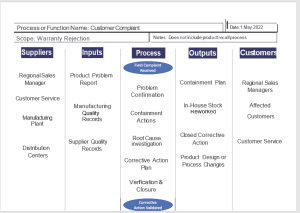SIPOC Diagram


“If you define the problem correctly, you almost have the solution.” – Steve Jobs
Introduction
The term ‘Life Skills’ refers to the skills you need to make the most out of life. Any skill that is useful in your life can be considered a life skill. There are five key life skills which include communication, interpersonal skills, decision making, problem-solving and critical thinking. However, perhaps the most important life skill is the ability and willingness to learn.
Objective
SIPOC diagram is one of the oldest and most trusted ways to map a business process in the most general way. It gives a birds-eye overview of the process that could help an organization map its business processes.
Although its use is easy and extremely important, there are still few organizations that choose to use it. The following text describes more information about the SIPOC diagram and includes some of the numerous benefits that its use can bring.
Definition (ISO 9000: 2015):
Customer (Cl 3.2.4): Person or organization that could or does receive a product or a service that is intended for or required by this person or organization
Supplier (Cl 3.2.5): Organization that provides a product or a service
Process (Cl 3.4.1): Set of interrelated or interacting activities that uses input to deliver an intended output
Output (Cl 3.7.5): Result of a process
Performance (Cl 3.7.8): Measurable result
Measurement (Cl 3.11.4): Process to determine a value
Read More: https://bit.ly/WhatEmbeddedSoftware
Detailed Information
A SIPOC (Supplier, Input, Process, Output, Customer) diagram is a visual tool for documenting a business process from beginning to end before implementation. It is also referred to as high-level process maps because they do not contain much detail.
In Six Sigma, SIPOC is often used during the “define” phase of the DMAIC (define, measure, analyze, improve, control) methodology.
Additionally, a SIPOC diagram can be helpful when parts of a process are unclear. It forces team members to identify and provide information. The SIPOC approach is a straightforward but also very simplistic way of mapping a business process. It is best used in addition to other techniques.
Read More: https://bit.ly/PESTLEANALYSIS
Linkage with ISO Standard
There are numerous clauses in ISO 9001:2015/IATF 16949: 2016 standard, which can be addressed, by using a SIPOC chart such as follows.
- 1 Understanding the organization and its context
- 2 Interested parties
- 4 Management system process
- 1 Risk Management
- 2 Requirement of product and services (Customer)
- 4 Externally provided processes (Supplier)
Is a SIPOC diagram required in ISO 9001:2015 / IATF 16949: 2016?
There are no requirements for organizations to develop SIPOC Diagrams! ISO 9001, Clause 4.1 states, “The organization shall identify the processes needed for the QMS and their application throughout the organization and determine the sequence and interaction of these processes.”
There may not be a requirement specifically for the SIPOC diagram, but it may help each organization to meet the requirements to determine and manage numerous linked activities to enable the transformation of inputs and outputs.
Read More: https://bit.ly/WhatisCyberSecurity
How to use a SIPOC Diagram?
Creating a SIPOC diagram is best done by using a cross-functional team, by following a specific sequence of steps:
- Processes
- Outputs
- Customers
- Inputs
- Suppliers
Read More: https://bit.ly/DiagramTurtleDiagram
This center-out approach works very well since most teams can quickly recite their work processes, but do not always know who their customers and suppliers are. This is especially true in large companies (or matrix structures) where functions are often siloed, with little supplier and customer interaction.
- Process: refers to the steps that make up a process. It connects the inputs with the outputs of the process. It represents a process map including 4-5 high-level steps. Example: Key steps for solving a customer complaint or conducting an interview.
- Outputs: the key products or services resulting from the process. Both inputs and outputs can be any type of resource or completed actions. The outputs are broad and neutral and reflect the value required by the customer. Example: Engineering drawing can be an output of a design process or a purchase order is the output of purchasing process.
- Customer: refers to anyone who benefits from the process outputs. Both suppliers and customers can be internal or external to the organization. For example, an External customer could be the person who issued the complaint to the organization or the person who requested the recruitment of a resource in their department.
- Inputs: resources, material, equipment, or data required to complete the process and produce the outputs. These entities are provided by the suppliers. It’s important to capture the most significant inputs. Example: For the preparation of the drawing, the inputs like the technical specification, customer requirements, etc., or for an interview, the key competence needed for the designer for the selection process.
- Suppliers: the providers of inputs to the process that have a direct impact on the outputs. They can be internal to the organization or third parties. For example, the suppliers can be a maintenance team, line operators, and contractors. They all influence the output of the process – upgrading to the new production line.

Read More: https://bit.ly/GeneralDataPR
Possible Benefits
- Easy-to-understand document
- Easy tool for use in audits
- Increases transparency across an organization
- Provides an overview of a project for stakeholders
- Can be used as a training tool for newer employees
Read More: https://bit.ly/FaultTreeAnalysisFTA
Industry Challenges:
- How often SIPOC diagrams are prepared by the cross-functional team?
- How often the SIPOC diagram is reviewed once it is prepared (any review frequency)?
- How often does the senior management analyze the benefits the organization is getting by preparing a SIPOC diagram?
Read More: https://bit.ly/SWOTAnalysisEV
References:
ISO 9001: 2015
IATF 16949: 2016
IATF 16949: 2016, Sanctioned Interpretation & FAQ
Industry Experts
This is the 158th article of this Quality Management series. Every weekend, you will find useful information that will make your Management System journey Productive. Please share it with your colleagues too.
In the words of Albert Einstein, “The important thing is never to stop questioning.” I invite you to ask anything about the above subject. Questions and answers are the lifeblood of learning, and we are all learning. I will answer all questions to the best of my ability and promise to keep personal information confidential.
Your genuine feedback and response are extremely valuable. Please suggest topics for the coming weeks.

thanks you so much sir for providing best definition of almost all key points of business. I was searching related sipoc topic definition and I found your blog.
simple and well explained .
Dear Sachin, Thanks for going through the blog and getting benefitted.